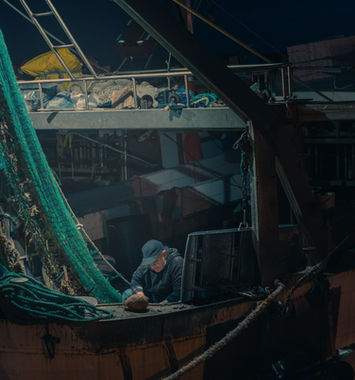
Dark webs: Uncovering those behind forced labour on commercial fishing fleets
The report is the most extensive analysis of forced labour abuses in commercial fishing vessels to date. It also found that companies from just five countries—China, Taiwan, Thailand, South Korea, and Spain—own almost two-thirds of accused vessels for which legal ownership data is available.
Published: November 15, 2023
Executive Summary
______
Forced labour in the fisheries sector is increasingly recognised as a human rights crisis. In 2021 alone, 128,000 fishers were trapped in forced labour aboard fishing vessels, often whilst in the high seas where workers are isolated, conditions are hazardous and there is little regulatory oversight, though this figure “likely significantly understates the full extent of the problem”, according to the International Labour Organization (ILO).
Forced labour is defined by the ILO as “all work or service which is exacted from any person under the menace of any penalty and for which the said person has not offered himself voluntarily.” The ILO provides a framework of 11 forced labour risk indicators that also apply to the fishing sector. This includes physical violence, debt-bonded labour, and abusive working and living conditions.
Labour exploitation is particularly widespread aboard distant water fishing fleets from many countries that have not ratified these key labour protection agreements, that is, commercial fishing vessels that operate outside a nation’s 200-mile exclusive economic zone (EEZ), whether on the high seas or in another nation’s EEZ. It is estimated that between 57,000 to 100,000 individuals work on these vessels in the high seas, many of whom may have been forced labour victims.
However, beneficial ownership information is rarely, if ever requested, by most countries when registering vessels or requesting fishing licences, meaning that those ultimately responsible for the abuses are not detected and punished. Making matters worse, they often use complex, cross-jurisdictional corporate structures to mask their ownership, ranging from using shell companies to setting up joint ventures which may be spread around the world.
Despite these challenges, this report sheds light on the main companies behind force labour violations, carrying out the largest ownership analysis of these incidents in commercial fleets to date. To achieve this, we built a database of nearly 500 commercial fishing vessels accused of forced labour between January 2010 and May 2023, one of the largest in the world, and compared it with another dataset of over 1,000 vessels accused of illegal, unreported and unregulated (IUU) fishing, five times more than the IUU unified list from regional fisheries management organisations for that same period. We also used S&P Lloyd’s Global IHS Markit, Orbis Moody’s and local ownership registries to identify as far as possible the legal and beneficial owners of these vessels. Due to lack of verification of declared beneficial owners in these databases, we state that we found natural persons identified as shareholders rather than beneficial owners due to the concern of identified shareholders being actually nominees, i.e. acting on behalf of others and thus not being the real beneficial owners.
______







